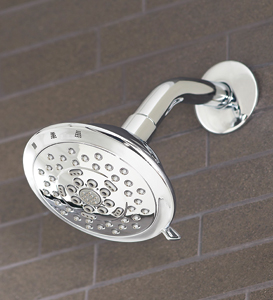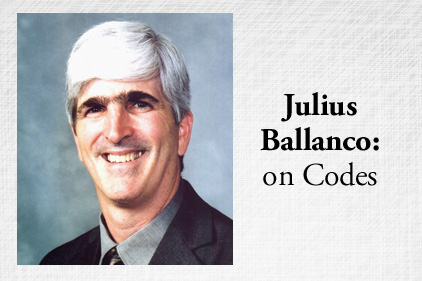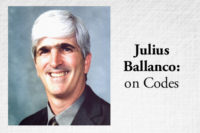
|
|
ASPE recommended a change to lower the trap size for showers based on the flow rates through a showerhead and a 1 1/2-in. drain pitched 1/4-in per ft. Photo courtesy of Danze. |
In last month’s column, I reviewed the start of the consensus process leading up to the 2015 IAPMO Uniform Plumbing Code.
While it was a mixed blessing, by the time the code changes got around to the hot-and-heavy technical portion, there were some strange outcomes. ASPE submitted many of the technical changes.
Reasons for not accepting a change must be technically justified. On the flipside, if a change is recommended to be accepted, the justification can solely be based on the proponent’s reason. As often happens, technical reasons get muddied up when a group merely doesn’t like a code change.
ASPE’s change to lower the trap size for showers is a good example of a well-documented code change. The change would lower the trap size from 2 in. to 1 1/2 in. The substantiation was based on the flow rates through a showerhead and the flow rates through a 1 1/2-in. drain pitched 1/4-in. per ft. The pipe could handle twice the showerhead flow rate. ASPE even had the support of the shower manufacturers.
For some reason, shower drains are a hot-button issue for the Friends of the United Association. FUA successfully convinced the committee to vote in opposition. The technical reason for rejecting the change is unique. It states: “The reason that a 1 1/2-in. trap works for a tub/shower combo and not a shower is that a tub/shower combo generally has an overflow that prevents water from spilling over the top of the fixture. Furthermore, it is extremely difficult to clean hair out of a 1 1/2-in. shower trap.”
To say the least, that is a bizarre statement. One has to wonder why all the 1 1/2-in. showers installed across the country work so well. They are not supposed to because there isn’t an overflow. It doesn’t seem to matter that other plumbing codes have allowed 1 1/2-in. shower drains for more than 25 years.
Another ASPE change would have removed the 2 1/2-in. dimension from the drainage and vent sizing table. Everyone on the Technical Committee agreed that 2 1/2-in. drainage pipe has not been manufactured for decades. However, the change still was rejected with the reason given as: “No technical documentation was provided to support requiring a vertical wet vent to be 2 times vs. 1 time larger than the minimum currently required. In addition, the proposed change does not solve the problem shown in the substantiation.” What that justification has to do with removing a nonexistent pipe size is anybody’s guess.
Time to vent
Under the venting section, there were competing changes to the horizontal wet-venting section. One change was proposed by ASPE, the other by FUA. The ASPE change was based on the technical content of all the ASPE documents, as well as the extensive research done on wet venting. That didn’t seem to matter. The committee accepted the FUA wet-venting change even though the change eliminates double bathroom group wet venting. The FUA change also uses the term “conventional venting” — whatever that means.
Of course, what would a discussion on venting be without a code change on air-admittance valves? ASPE submitted a complete AAV change based on the recommendations in its design handbook. That didn’t stop FUA from vigorously opposing AAVs.
The justification statement was rather contradictory. It states: “The committee has presented arguments and reasons for rejection of this item as shown in the report on proposals and report on comments from previous code-development cycles. The committee is concerned of the possibility that a mechanical AAV device will fail. The installation of an AAV would not be in compliance with Section 1002.1. The committee notes that AAVs could be installed under Section 301.4 for an Alternative Engineered Design or Section 301.2 for Alternate Materials and Methods of Construction Equivalency.”
In one breath, FUA say there are past technical reasons for not accepting AAVs. In the next breath, they state AAVs should be accepted as an alternative material, which means they work. So do they work or not?
Another venting change proposed to move the circuit venting from the appendix to Chapter 9. The committee recommended approval of the change. Also removed would be the requirement that circuit venting be designed by an engineer. While this received favorable consideration at the meeting, FUA voted against the change in the letter ballot. The letter ballot did not receive the required two-thirds vote, so it officially gets recorded as no decision.
ASPE changes to the storm drainage section would have rewritten the method used for sizing based on the research report of the ASPE Research Foundation. The research was conducted at IAPMO R&T test labs. One would think that a peer-reviewed research report with research done by IAPMO would be good enough. Not for FUA. The change was rejected. The first sentence of the justification was, “The committee believes that the current provisions within the UPC provide the necessary requirements for the installation of roof drainage systems.”
I must strongly disagree since the extensive report outlined how the current sizing method will result in failure. One of the problems could have been that the research report was too long to read.
Comedy central
There always is some comic relief at code hearings. There was a proposed change to rewrite all the medical gas sizing tables to be consistent with what is published by ASPE. The original motion and vote was to reject the code change. However, nobody could come up with a technical reason for rejecting the new tables. The committee switched its vote to approval based on the proponent’s substantiation.
A number of other changes to the medical gas section will bring the Uniform Plumbing Code in line with NFPA 99. All the changes were recommended for approval.
Other major technical changes include the rewrite of the alternative water source chapters. These changes would make the code consistent with the Green Code Supplement. All the changes were approved.
There was an extensive change to rewrite the water pipe sizing method in Appendix A. While my name was listed as the proponent, I will admit that I worked with a group of individuals to write the change. The change was very comprehensive, which can often be the downfall of the change. The revised tables would have made the code consistent with the sizing method published by ASPE and new tables would have been added for all the water piping materials. Hunter’s Curve would have been replaced with a table showing the Hunter’s Curve values. The change was recommended for rejection based on the fact that a study currently is underway to analyze and develop a new water pipe sizing method.
IAPMO will publish the results of the meeting within the next month. You can download the results at www.iapmo.org.
HELPFUL LINKS:


